The Characteristics and Evaluation of Future Droughts across China through the CMIP6 Multi-Model Ensemble
Abstract
:1. Introduction
2. Materials and Methods
2.1. Study Area
2.2. Materials
2.3. Methods
2.3.1. SPEI
2.3.2. Drought Characterization
2.3.3. Simulation Assessment
2.3.4. Mutation Test for Historical SPEI
2.3.5. Trend Analysis and Significance Test
3. Results
3.1. Assessment of CMIP6 Climate Models
3.2. Assessment of Historical Droughts
3.2.1. Historical Drought Characteristics across China
3.2.2. Historical Drought Trends across China
3.3. Future Drought under the Investigated SSP Scenarios
3.3.1. Future Changes in Drought Characteristics across China
3.3.2. Trend of Future Droughts across China
4. Discussion
4.1. Uncertainty Analysis of the Simulation Capability of CMIP6
4.2. Evolution of Future Drought Characteristics
4.3. Limitation and Future Research
5. Conclusions
- (1)
- In terms of historical periods, northwest IRB has been prone to seasonal drought with long DD and high DI, southwest and northeast China have been prone to seasonal drought of high frequency and low DI, and areas near the midstream and downstream of the YZRB have been prone to seasonal drought of long DD and low DI. The DF, DD, and DI in the northwest IRB and YZRB increased significantly after 1991, and the drought trend in China was more serious in summer and autumn.
- (2)
- In terms of the future period, a lower DF, longer DD, and more serious DI across China correspond to the higher emission scenarios. The PRB, SERB, and northwest IRB are more prone to sustained seasonal drought. DF across China under the SSP5-8.5 scenario will be more frequent than that in other scenarios, especially southwest of the IRB, YRB, and HURB, with extreme DF > 2%. The range of change in SPEI in the higher emission scenarios is significantly greater than that in the lower emission scenarios. Aridity of northern China is more serious than that of southern China, that of the IRB is more serious than that of other regions, that of western plateau regions are more serious than that of eastern plain regions, and the wetting of southwest marginal regions of China is more serious.
- (3)
- Compared with the historical period, under the low and medium emission scenarios, China will suffer more frequent drought events, and the DD and DI will be weakened, whereas China will suffer longer DD and more serious drought events under the medium-high and higher emission scenarios, especially in the IRB, PRB, HURB, SERB, and downstream of the YZRB. For all scenarios, there will be greater DF in the future in the SLRB, SWRB, and midstream and upstream of the YZRB. Although the DF in most of China is prone to decreasing, the frequency of extreme droughts is expected to increase under the high emission scenarios. It is worth noting that compared with historical periods, in most scenarios, HARB and HURB are expected to experience a more serious drought trend in summer, with increases of 2.9–5.7 and 1.1–4.2, respectively.
Author Contributions
Funding
Institutional Review Board Statement
Informed Consent Statement
Data Availability Statement
Acknowledgments
Conflicts of Interest
References
- IPCC. Climate change 2013: The physical science basis. In Contribution of Working Group I to Thefifth Assessment Report of the Intergovernmental Panel on Climate Change; Cambridge University Press: Cambridge, UK, 2021; pp. 1–195. [Google Scholar]
- Allen, M.R.; Ingram, W.J. Constraints on future changes in climate and the hydrologic cycle. Nature 2002, 419, 224–232. [Google Scholar] [CrossRef]
- Zhang, Q.; Li, J.; Singh, V.P.; Xiao, M. Spatio-temporal relations between temperature and precipitation regimes: Implications for temperature-induced changes in the hydrological cycle. Glob. Planet. Change 2013, 111, 57–76. [Google Scholar] [CrossRef]
- Hu, P.; Zhang, Q.; Shi, P.; Chen, B.; Fang, J. Flood-induced mortality across the globe: Spatiotemporal pattern and influencing factors. Sci. Total Environ. 2018, 643, 171–182. [Google Scholar] [CrossRef] [PubMed]
- Zong, Y.; Chen, X. The 1998 Flood on the Yangtze, China. Nat. Hazards 2000, 22, 165–184. [Google Scholar] [CrossRef]
- Sun, Y.; Zhang, X.; Zwiers, F.W.; Song, L.; Wan, H.; Hu, T.; Yin, H.; Ren, G. Rapid increase in the risk of extreme summer heat in Eastern China. Nat. Clim. Change 2014, 4, 1082–1085. [Google Scholar] [CrossRef]
- Shen, H.; Zhao, J.; Cheung, K.Y.; Chen, L.; Yu, X.; Wen, T.; Gong, Z.; Feng, G. Causes of the extreme snowfall anomaly over the northeast Tibetan plateau in early winter 2018. Clim. Dynam. 2018, 56, 1767–1782. [Google Scholar] [CrossRef]
- Su, X.; Shao, W.; Liu, J.; Jiang, Y.; Wang, K. Dynamic Assessment of the Impact of Flood Disaster on Economy and Population under Extreme Rainstorm Events. Remote Sens. 2021, 13, 3924. [Google Scholar] [CrossRef]
- Yu, M.; Li, Q.; Hayes, M.J.; Svoboda, M.D.; Heim, R.R. Are droughts becoming more frequent or severe in China based on the standardized precipitation evapotranspiration index: 1951–2010. Int. J. Climatol. 2014, 34, 545–558. [Google Scholar] [CrossRef]
- Battisti, D.S.; Naylor, R.L. Historical warnings of future food insecurity with unprecedented seasonal heat. Science 2009, 323, 240–244. [Google Scholar] [CrossRef] [Green Version]
- He, J.; Yang, X.; Li, Z.; Tang, Q. Spatiotemporal Variations of Meteorological Droughts in China During 1961–2014: An Investigation Based on Multi-Threshold Identification. Int. J. Disast. Risk Sci. 2016, 7, 63–76. [Google Scholar] [CrossRef] [Green Version]
- Zhang, Q.; Yu, H.; Sun, P.; Singh, V.P.; Shi, P. Multisource data based agricultural drought monitoring and agricultural loss in China. Glob. Planet. Change 2019, 172, 298–306. [Google Scholar] [CrossRef]
- Lambert, S.J.; Boer, G.J. CIMP1 evaluation and intercomparison of coupled climate models. Clim. Dynam. 2001, 17, 83–106. [Google Scholar] [CrossRef]
- Behrens, L.K.; Martin, T.; Semenov, V.A.; Latif, M. The Arctic sea ice in the CMIP3 climate model ensemble—variability and anthropogenic change. Cryosphere Discuss. 2012, 6, 5317–5344. [Google Scholar] [CrossRef] [Green Version]
- Torres, R.R.; Marengo, J.A. Climate change hotspots over South America: From CMIP3 to CMIP5 multi-model datasets. Theor. Appl. Climatol. 2014, 117, 579–587. [Google Scholar] [CrossRef]
- Eyring, V.; Bony, S.; Meehl, G.A.; Senior, C.; Taylor, K.E. Overview of the Coupled Model Intercomparison Project Phase 6 (CMIP6) experimental design and organization. Geosci. Model Dev. 2016, 9, 1937–1958. [Google Scholar] [CrossRef] [Green Version]
- Oneill, B.C.; Tebaldi, C.; Van Vuuren, D.P.; Eyring, V.; Friedlingstein, P.; Hurtt, G.C.; Knutti, R.; Kriegler, E.; Lamarque, J.; Lowe, J. The Scenario Model Intercomparison Project (ScenarioMIP) for CMIP6. Geosci. Model Dev. 2016, 9, 3461–3482. [Google Scholar] [CrossRef] [Green Version]
- Xu, C.H.; Xu, Y. The projection of temperature and precipitation over China under RCP scenarios using a CMIP5 multi-model ensemble. Atmos. Ocean. Sci. Lett. 2012, 9, 527–533. [Google Scholar] [CrossRef] [Green Version]
- Hu, Q.; Jiang, D.B.; Fan, G.Z. Evaluation of CMIP5 models over the Qinghai–Tibetan Plateau. Chin. J. Atmos. Sci. 2014, 38, 924–938. (In Chinese) [Google Scholar]
- Huang, J.; Zhai, J.; Jiang, T.; Wang, Y.; Li, X.; Wang, R.; Xiong, M.; Su, B.; Fischer, T. Analysis of future drought characteristics in China using the regional climate model CCLM. Clim. Dynam. 2017, 50, 507–525. [Google Scholar] [CrossRef]
- Wang, Z.; Zhong, R.; Lai, C.; Zeng, Z.; Lian, Y.; Bai, X. Climate change enhances the severity and variability of drought in the Pearl River Basin in South China in the 21st century. Agr. For. Meteorol. 2018, 249, 149–162. [Google Scholar] [CrossRef]
- Yao, N.; Li, L.; Feng, P.; Feng, H.; Li, Y. Projections of drought characteristics in China based on a standardized precipitation and evapotranspiration index and multiple GCMs. Sci. Total Environ. 2020, 704, 135245. [Google Scholar] [CrossRef] [PubMed]
- Han, R.C.; Li, Z.L.; Li, Z.J.; Han, Y.Y. Spatial—Temporal Assessment of Historical and Future Meteorological Droughts in China. Atmosphere 2021, 12, 787. [Google Scholar] [CrossRef]
- Su, B.; Huang, J.; Mondal, S.K.; Zhai, J.; Wang, Y.; Wen, S.; Gao, M.; Lv, Y.; Jiang, S.; Jiang, T.; et al. Insight from CMIP6 SSP-RCP scenarios for future drought characteristics in China. Atmos. Res. 2021, 250, 105375. [Google Scholar] [CrossRef]
- Zhu, Y.; Yang, S. Interdecadal and interannual evolution characteristics of the global surface precipitation anomaly shown by CMIP5 and CMIP6 models. Int. J. Climatol. 2021, 41, 1100–1118. [Google Scholar] [CrossRef]
- Mondal, S.K.; Huang, J.; Wang, Y.; Su, B.; Zhai, J.; Tao, H.; Wang, G.; Fischer, T.; Wen, S.; Jiang, T. Doubling of the population exposed to drought over South Asia: CMIP6 multi-model-based analysis. Sci. Total Environ. 2021, 771, 145186. [Google Scholar] [CrossRef] [PubMed]
- Zargar, A.; Sadiq, R.; Naser, B.; Khan, F.I. A Review of Drought Indices. Environ. Rev. 2011, 19, 333–349. [Google Scholar] [CrossRef]
- Vicente-Serrano, S.M.; Beguería, S.; López-Moreno, J.I.; Marta, A.M. A multiscalar drought index sensitive to global warming: The standardized precipitation evapotranspiration index. J. Clim. 2010, 23, 1696–1718. [Google Scholar] [CrossRef] [Green Version]
- McKee, T.B.; Doesken, N.J.; Kleist, J. The Relationship of Drought Frequency and Duration to Time Scales. In Proceedings of the 8th Conference on Applied Climatology, Anaheim, CA, USA, 17–22 January 1993. [Google Scholar]
- Palmer, W.C. Meteorological Drought. In Research Paper No. 45; US Department of Commerce: Washington, DC, USA, 1965; p. 58. [Google Scholar]
- Xu, K.; Yang, D.; Yang, H.; Li, Z.; Qin, Y.; Shen, Y. Spatio-Temporal Variation of Drought in China During 1961–2012: A Climatic Perspective. J. Hydrol. 2015, 526, 253–264. [Google Scholar] [CrossRef]
- Zuo, D.; Cai, S.; Xu, Z.; Li, F.; Sun, W.; Yang, X.; Kan, G.; Liu, P. Spatiotemporal Patterns of Drought at Various Time Scales in Shandong Province of Eastern China. Theor. Appl. Climatol. 2018, 131, 271–284. [Google Scholar] [CrossRef]
- Ye, L.; Shi, K.; Zhang, H.; Xin, Z.; Hu, J.; Zhang, C. Spatio-Temporal Analysis of Drought Indicated by SPEI over Northeastern China. Water 2019, 11, 908. [Google Scholar] [CrossRef] [Green Version]
- Li, L.; She, D.; Zheng, H.; Lin, P.; Yang, Z. Elucidating diverse drought characteristics from two meteorological drought indices (SPI and SPEI) in China. J. Hydrometeorol. 2020, 21, 1513–1530. [Google Scholar] [CrossRef]
- Thornthwaite, C.W. An Approach toward a Rational Classification of Climate. Geograph. Rev. 1948, 38, 55–94. [Google Scholar] [CrossRef]
- Potop, V.; Boroneant, C.; Možný, M.; Štěpánek, P.; Skalák, P. Observed spatiotemporal characteristics of drought on various time scales over the Czech Republic. Theor. Appl. Climatol. 2013, 115, 563–581. [Google Scholar] [CrossRef]
- Jin, X.; Qiang, H.; Zhao, L.; Jiang, S.; Cui, N.; Cao, Y.; Feng, Y. SPEI-based analysis of spatio-temporal variation characteristics for annual and seasonal drought in the Zoige Wetland, Southwest China from 1961 to 2016. Theor. Appl. Climatol. 2019, 139, 711–725. [Google Scholar] [CrossRef]
- Beguería, S.; Vicente-Serrano, S.M.; Reig, F.; Latorre, B. Standardized precipitation evapotranspiration index (SPEI) revisited: Parameter fitting, evapotranspiration models, tools, datasets and drought monitoring. Int. J. Climatol. 2014, 3023, 3001–3023. [Google Scholar] [CrossRef] [Green Version]
- World Meteorological Organization (WMO). Integrated Drought Management Programme Handbook of Drought Indicators and Indices. No 1173. 2016. Available online: https://www.droughtmanagement.info/literature/GWP_Handbook_of_Drought_Indicators_and_Indices_2016.pdf (accessed on 17 December 2021).
- Herbst, P.H.; Bredenkamp, D.B.; Barker, H. A technique for the evaluation of drought from rainfall data. J. Hydrol. 1966, 4, 264–272. [Google Scholar] [CrossRef]
- Wang, F.; Wang, Z.; Yang, H.; Di, D.; Zhao, Y.; Liang, Q.; Hussain, Z. Comprehensive evaluation of hydrological drought and its relationships with meteorological drought in the Yellow River basin, China. J. Hydrol. 2020, 548, 124751. [Google Scholar] [CrossRef]
- Haile, G.G.; Tang, Q.; Leng, G.; Jia, G.; Wang, J.; Cai, D.; Sun, S.; Banyia, B.; Zhang, Q. Long-term spatiotemporal variation of drought patterns over the Greater Horn of Africa. Sci. Total Environ. 2020, 704, 135299. [Google Scholar] [CrossRef]
- Li, Y.; Tong, S.; Bao, Y.; Guo, E.; Bao, Y. Prediction of Droughts in the Mongolian Plateau Based on the CMIP5 Model. Water 2020, 12, 2774. [Google Scholar] [CrossRef]
- Taylor, K.E. Summarizing multiple aspects of model performance in a single diagram. J. Geophys. Res. Atmos. 2001, 106, 7183–7192. [Google Scholar] [CrossRef]
- Wei, F.Y. Statistical Diagnosis and Prediction Technology of Modern Climate; China Meteorological Press: Beijing, China, 1999. [Google Scholar]
- Theil, H. A rank-invariant method of linear and polynomial regression analysis. Nederl. Akad. Wetensch. Proc. 1992, 12, 345–381. [Google Scholar] [CrossRef]
- Hamed, K.H.; Rao, A.R. A modified Mann-Kendall trend test for autocorrelated data. J. Hydrol. 1998, 204, 182–196. [Google Scholar] [CrossRef]
- Zhang, Q.; Singh, V.P.; Peng, J.; Chen, Y.D.; Li, J. Spatial-temporal changes of precipitation structure across the Pearl River basin, China. J. Hydrol. 2012, 440, 113–122. [Google Scholar] [CrossRef]
- Daufresne, M.; Lengfellner, K.; Sommer, U. Global warming benefits the small in aquatic ecosystems. Proc. Natl. Acad. Sci. USA 2009, 106, 12788–12793. [Google Scholar] [CrossRef] [PubMed] [Green Version]
- Bracegirdle, T.J.; Stephenson, D.B.; Turner, J.; Phillips, T. The importance of sea ice area biases in 21st century multimodel projections of Antarctic temperature and precipitation. Geophys. Res. Lett. 2015, 42, 10832–10839. [Google Scholar] [CrossRef] [Green Version]
- Yang, X.; Wood, E.F.; Sheffield, J.; Ren, L.; Zhang, M.; Wang, Y. Bias Correction of Historical and Future Simulations of Precipitation and Temperature for China from CMIP5 Models. J. Hydrometeorol. 2018, 19, 609–623. [Google Scholar] [CrossRef]
- Chen, L.; Wang, G.; Miao, L.; Gnyawali, K.R.; Li, S.; Amankwah, S.O.Y.; Huang, J.; Lu, J.; Zhan, M. Future drought in CMIP6 projections and the socioeconomic impacts in China. Int. J. Climatol. 2021, 41, 4151–4170. [Google Scholar] [CrossRef]
- Zhang, G.; Gan, T.Y.; Su, X. Twenty-first century drought analysis across China under climate change. Clim. Dynam. 2021, 1–21. [Google Scholar] [CrossRef]
- Naumann, G.; Alfieri, L.; Wyser, K.; Mentaschi, L.; Betts, R.A.; Carrao, H.; Spinoni, J.; Vogt, J.; Feyen, L. Global Changes in Drought Conditions Under Different Levels of Warming. Geophys. Res. Lett. 2018, 45, 3285–3296. [Google Scholar] [CrossRef]
- Xu, Y.; Zhang, X.; Hao, Z.; Hao, F.; Li, C. Projections of future meteorological droughts in China under CMIP6 from a three-dimensional perspective. Agr. Water Manage. 2021, 252, 106849. [Google Scholar] [CrossRef]
- Chen, H.P.; Sun, J.Q.; Chen, X.L. Future Changes of Drought and Flood Events in China under a Global Warming Scenario. Atmos. Ocean. Sci. Lett. 2013, 6, 8–13. [Google Scholar] [CrossRef]
- Chen, H.; Sun, J. Characterizing present and future drought changes over eastern China. Int. J. Climatol. 2017, 37, 138–156. [Google Scholar] [CrossRef]
- Song, Z.; Xia, J.; She, D.; Li, L.; Hu, C.; Hong, S. Assessment of meteorological drought change in the 21st century based on CMIP6 multi-model ensemble projections over mainland China. J. Hydrol. 2021, 601, 126643. [Google Scholar] [CrossRef]
- Taylor, K.E.; Stoufer, R.J.; Meehl, G.A. An overview of CMIP5 and the experiment design. B. Am. Meteorol. Soc. 2012, 93, 485–498. [Google Scholar] [CrossRef] [Green Version]
- Eyring, V.; Cox, P.M.; Flato, G.M.; Gleckler, P.J.; Abramowitz, G.; Caldwell, P.; Collins, W.D.; Gier, B.K.; Hall, A.D.; Hoffman, F.M. Taking climate model evaluation to the next level. Nat. Clim. Change 2019, 9, 102–110. [Google Scholar] [CrossRef] [Green Version]
- Zhu, X.; Lee, S.Y.; Wen, X.; Ji, Z.; Lin, L.; Wei, Z.; Zheng, Z.; Xu, D.; Dong, W. Extreme climate changes over three major river basins in China as seen in CMIP5 and CMIP6. Clim. Dynam. 2021, 57, 1187–1205. [Google Scholar] [CrossRef]
- Swann, A.L.; Hoffman, F.M.; Koven, C.D.; Randerson, J.T. Plant responses to increasing CO2 reduce estimates of climate impacts on drought severity. Proc. Natl. Acad. Sci. USA 2016, 113, 10019–10024. [Google Scholar] [CrossRef] [Green Version]
- Swann, A.L. Plants and drought in a changing climate. Curr. Clim. Change Rep. 2018, 4, 192–201. [Google Scholar] [CrossRef] [Green Version]
- Swain, S.; Hayhoe, K. CMIP5 projected changes in spring and summer drought and wet conditions over North America. Clim. Dynam. 2015, 44, 2737–2750. [Google Scholar] [CrossRef]
- Park, C.K.; Byun, H.R.; Deo, R.; Lee, B.R. Drought prediction till 2100 under RCP 8.5 climate change scenarios for Korea. J. Hydrol. 2015, 526, 221–230. [Google Scholar] [CrossRef]

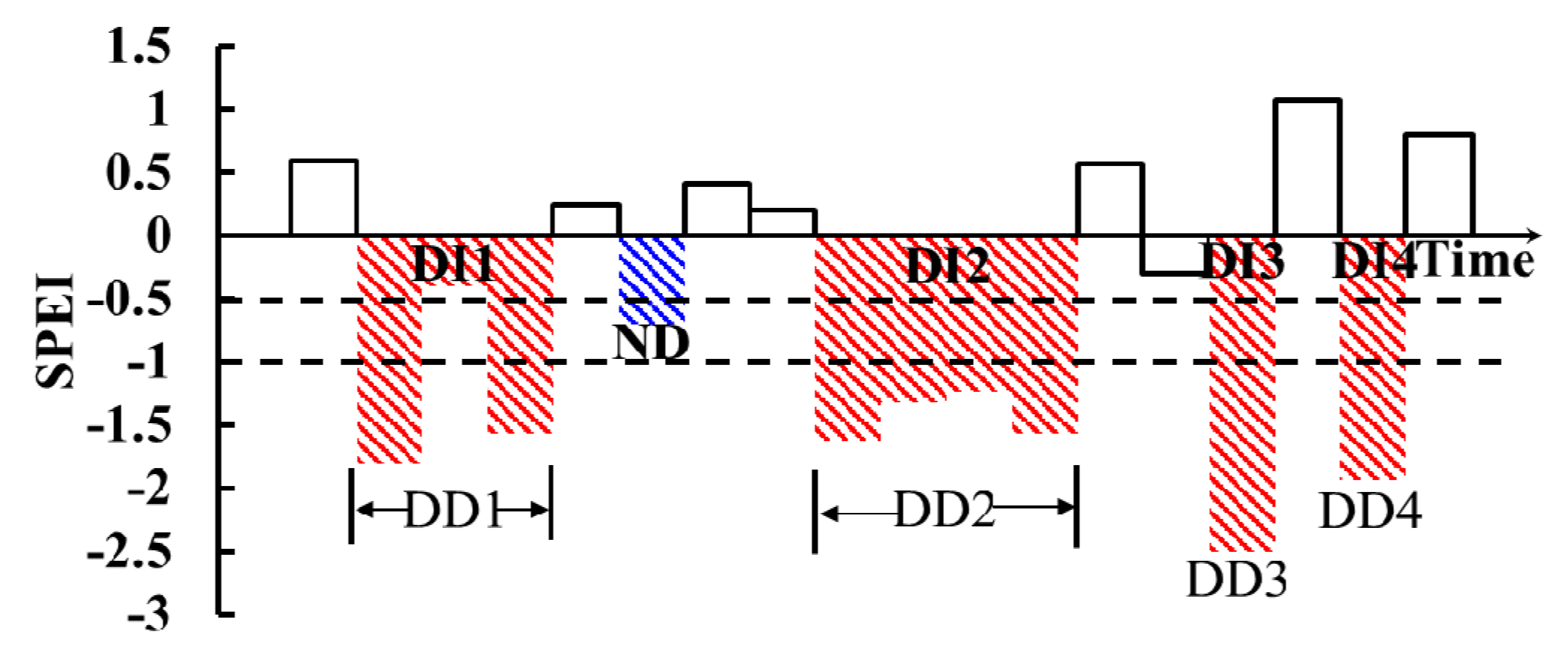
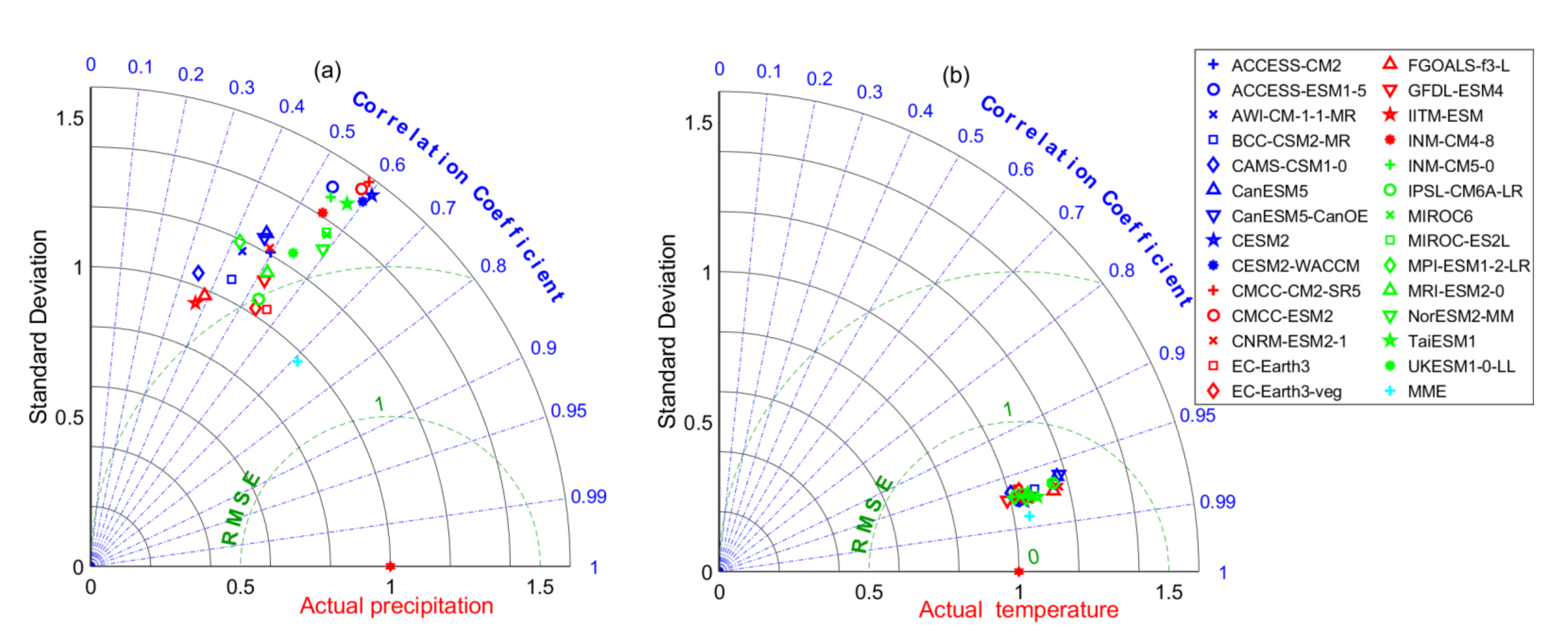
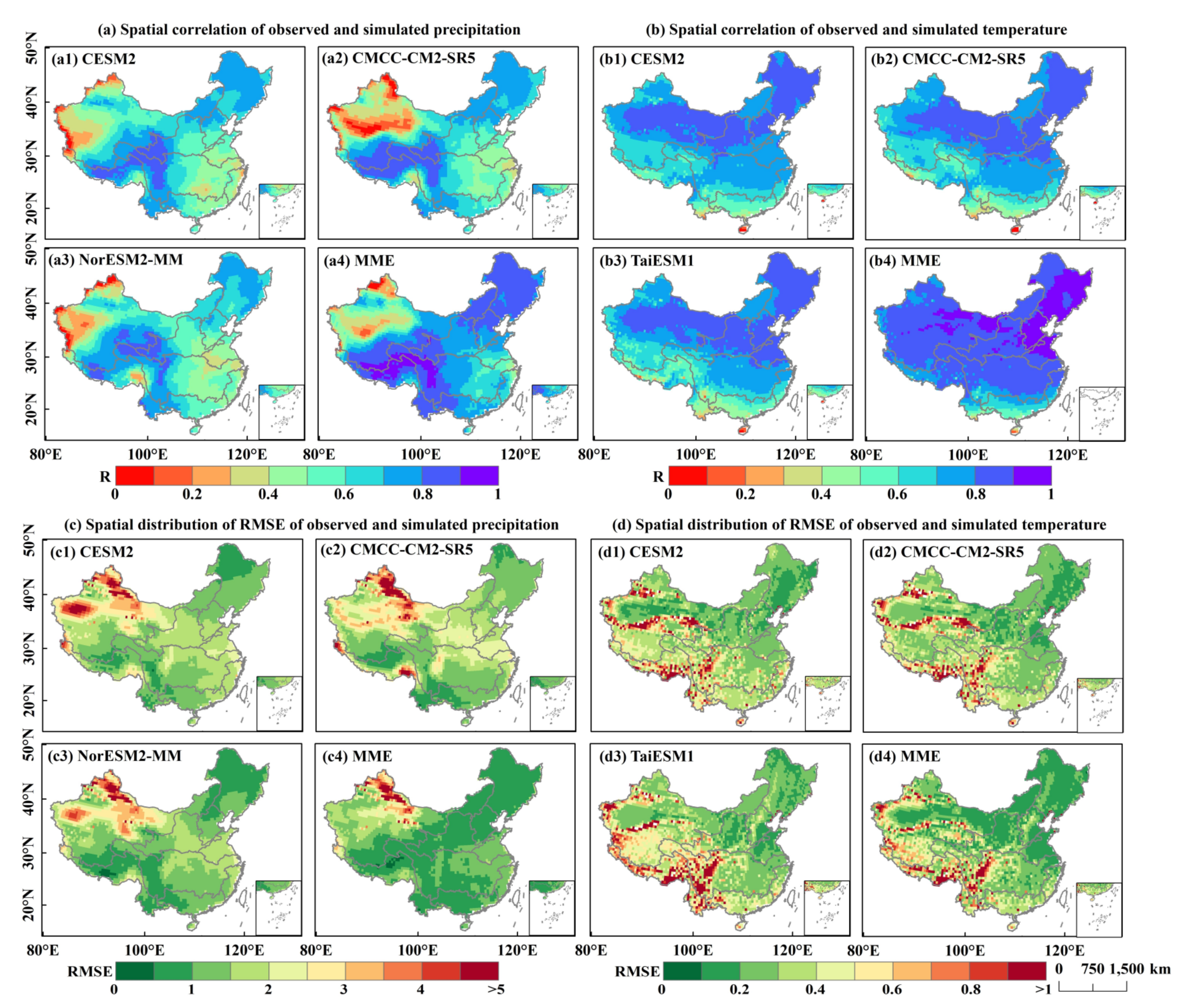
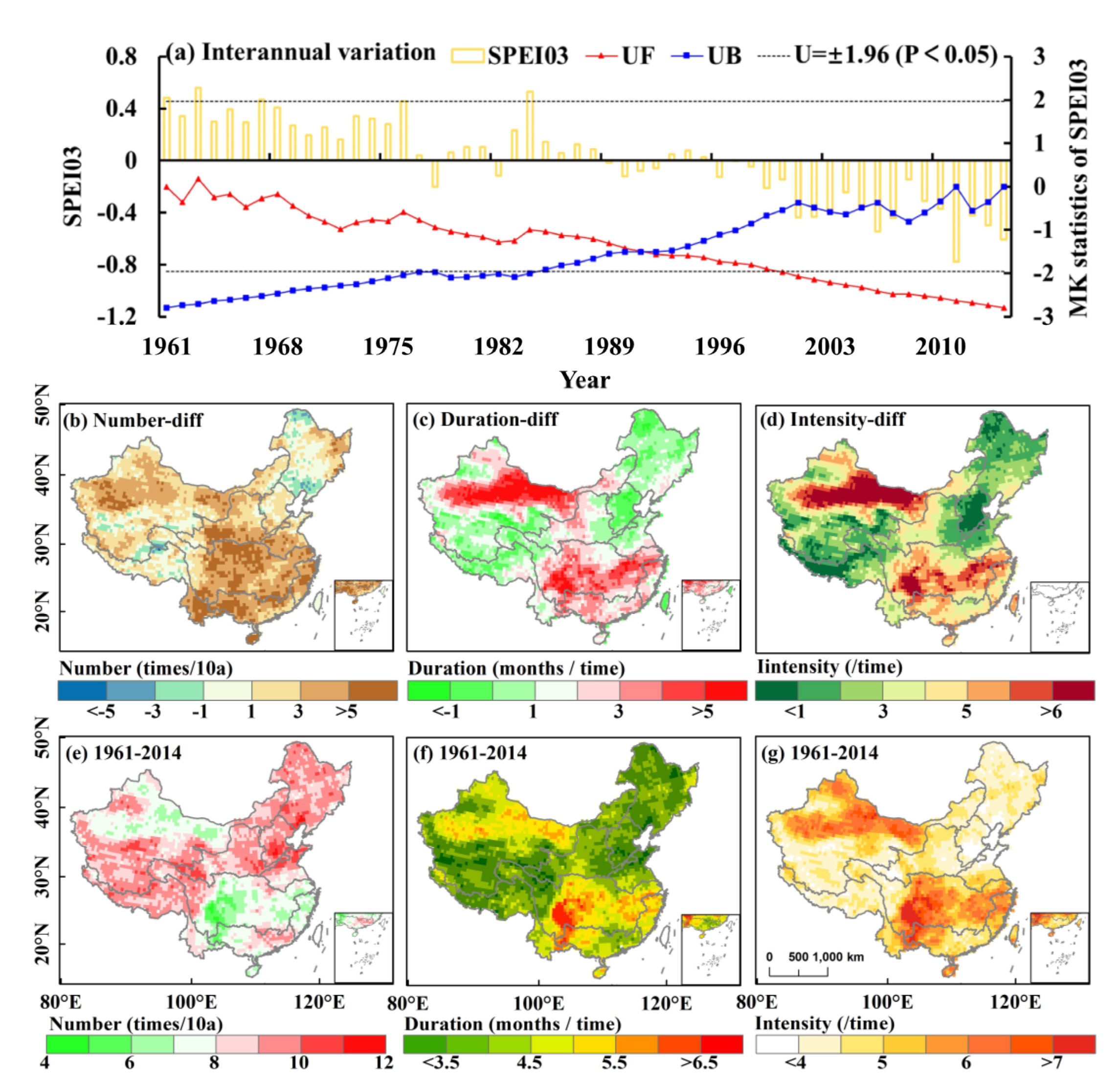




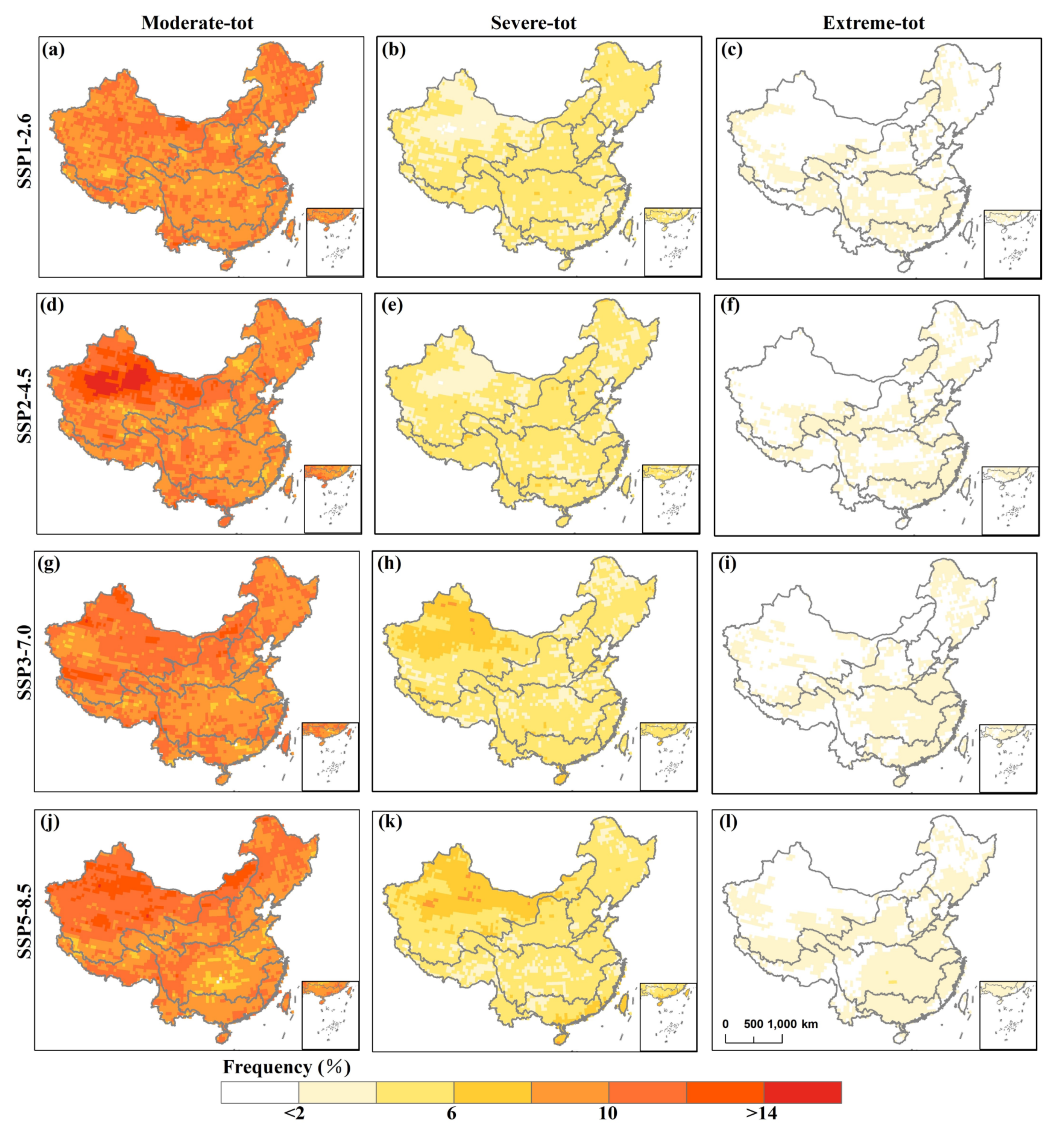
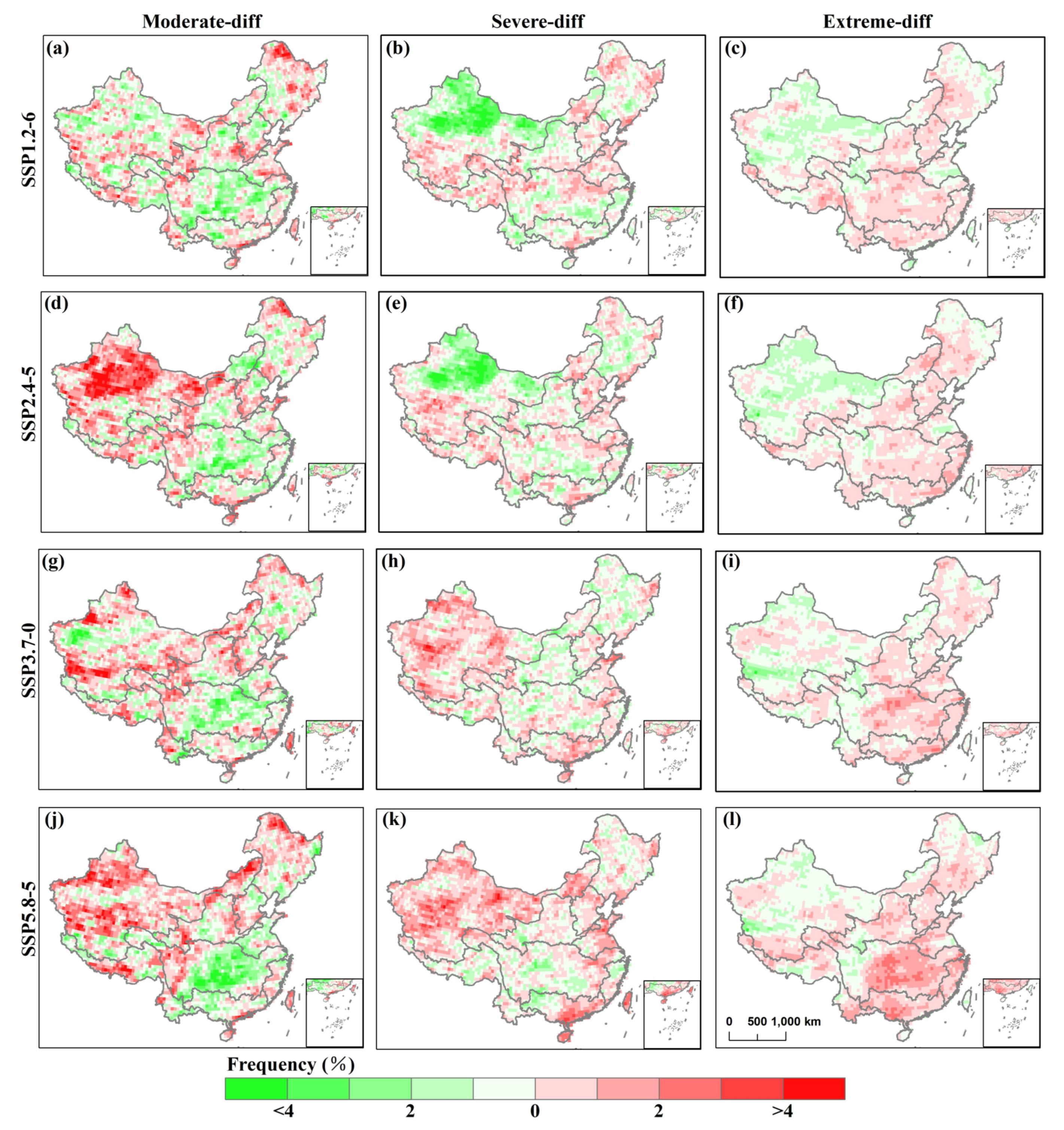

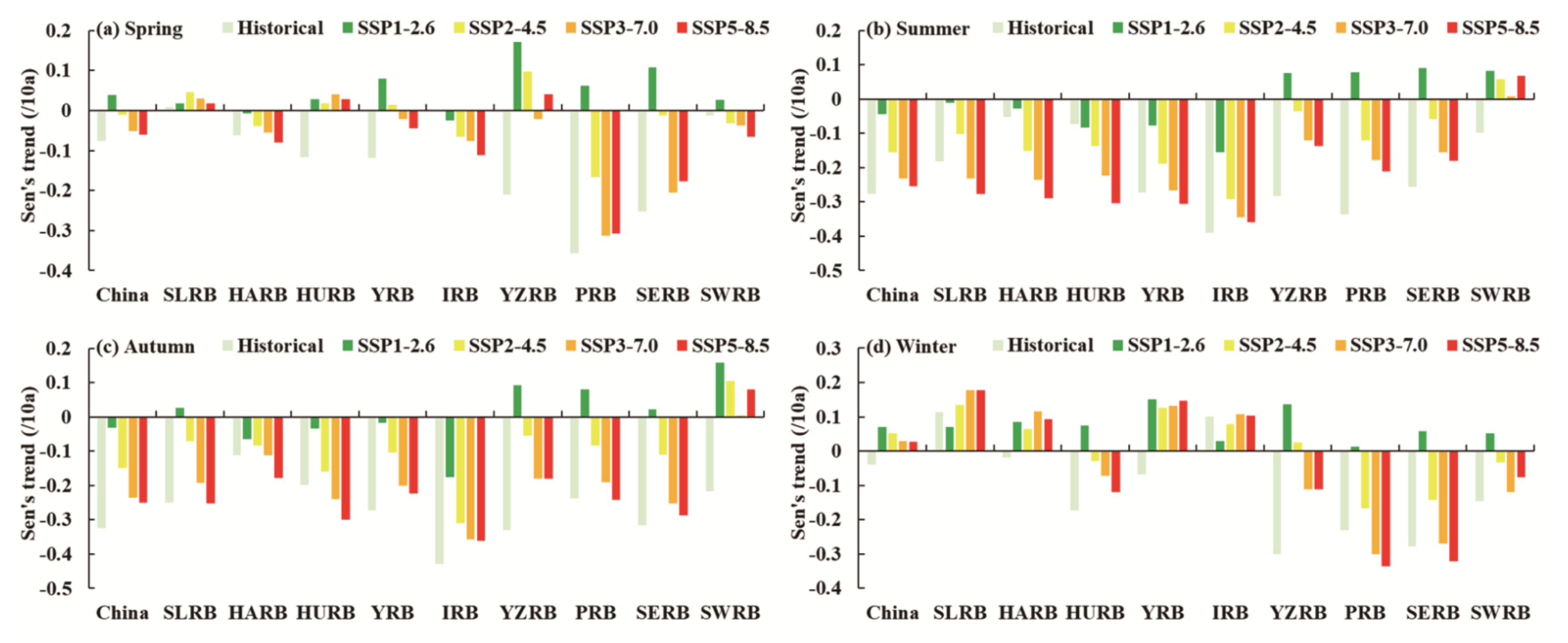
| No | Model | Institution | Country | Resolution |
|---|---|---|---|---|
| 1 | ACCESS-CM2 | CSIRO-BOM | Australia | 1.25° × 1.88° |
| 2 | ACCESS-ESM1-5 | CSIRO-BOM | Australia | 1.25° × 1.88° |
| 3 | AWI-CM-1-1-MR | AWI | USA | 0.94° × 0.94° |
| 4 | BCC-CSM2-MR | BBC | China | 1.10° × 1.10° |
| 5 | CAMS-CSM1-0 | CAMS | China | 1.10° × 1.10° |
| 6 | CanESM5 | CCCma | Canada | 2.81° × 2.81° |
| 7 | CanESM5-CanOE | CCCma | Canada | 2.81° × 2.81° |
| 8 | CESM2 | NCAR | USA | 1.25° × 0.94° |
| 9 | CESM2-WACCM | NCAR | USA | 1.25° × 0.94° |
| 10 | CMCC-CM2-SR5 | CMCC | Italian | 1.25° × 0.94° |
| 11 | CMCC-ESM2 | CMCC | Italian | 1.25° × 0.94° |
| 12 | CNRM-ESM2-1 | CNRM-CERFACS | France | 1.40° × 1.40° |
| 13 | EC-Earth3 | EC-Earth Consortium | Europe | 0.35° × 0.35° |
| 14 | EC-Earth3-Veg | EC-Earth Consortium | Europe | 0.35° × 0.35° |
| 15 | FGOALS-f3-L | CAS | China | 1.25° × 1.00° |
| 16 | GFDL-ESM4 | NOAA-GFDL | USA | 1.25° × 1.00° |
| 17 | IITM-ESM | IITM | Italian | 1.88° × 1.90° |
| 18 | INM-CM4-8 | INM | Russia | 2.00° × 1.50° |
| 19 | INM-CM5-0 | INM | Russia | 2.00° × 1.50° |
| 20 | IPSL-CM6A-LR | IPSL | France | 2.50° × 1.27° |
| 21 | MIROC6 | JAMSTEC | Japan | 1.40° × 1.40° |
| 22 | MIROC-ES2L | JAMSTEC | Japan | 2.81° × 2.81° |
| 23 | MPI-ESM1-2-HR | MPI-M | Germany | 0.94° × 0.94° |
| 24 | MRI-ESM2-0 | MRI | Japan | 1.13° × 1.13° |
| 25 | NorESM2-MM | NCC | Norway | 2.50° × 1.89° |
| 26 | TaiESM1 | CCliCS | China | 1.25° × 0.94° |
| 27 | UKESM1-0-LL | MOHC | Britain | 1.88° × 1.25° |
| Categories | SPEI Values |
|---|---|
| Normal | −0.5 ≤ SPEI |
| Slight dry | −1.00 ≤ SPEI < −0.50 |
| Moderate dry | −1.50 ≤ SPEI < −1.00 |
| Severe dry | −2.00 ≤ SPEI < −1.50 |
| Extreme dry | SPEI < −2.00 |
Publisher’s Note: MDPI stays neutral with regard to jurisdictional claims in published maps and institutional affiliations. |
© 2022 by the authors. Licensee MDPI, Basel, Switzerland. This article is an open access article distributed under the terms and conditions of the Creative Commons Attribution (CC BY) license (https://creativecommons.org/licenses/by/4.0/).
Share and Cite
Ma, Z.; Sun, P.; Zhang, Q.; Zou, Y.; Lv, Y.; Li, H.; Chen, D. The Characteristics and Evaluation of Future Droughts across China through the CMIP6 Multi-Model Ensemble. Remote Sens. 2022, 14, 1097. https://doi.org/10.3390/rs14051097
Ma Z, Sun P, Zhang Q, Zou Y, Lv Y, Li H, Chen D. The Characteristics and Evaluation of Future Droughts across China through the CMIP6 Multi-Model Ensemble. Remote Sensing. 2022; 14(5):1097. https://doi.org/10.3390/rs14051097
Chicago/Turabian StyleMa, Zice, Peng Sun, Qiang Zhang, Yifan Zou, Yinfeng Lv, Hu Li, and Donghua Chen. 2022. "The Characteristics and Evaluation of Future Droughts across China through the CMIP6 Multi-Model Ensemble" Remote Sensing 14, no. 5: 1097. https://doi.org/10.3390/rs14051097
APA StyleMa, Z., Sun, P., Zhang, Q., Zou, Y., Lv, Y., Li, H., & Chen, D. (2022). The Characteristics and Evaluation of Future Droughts across China through the CMIP6 Multi-Model Ensemble. Remote Sensing, 14(5), 1097. https://doi.org/10.3390/rs14051097








